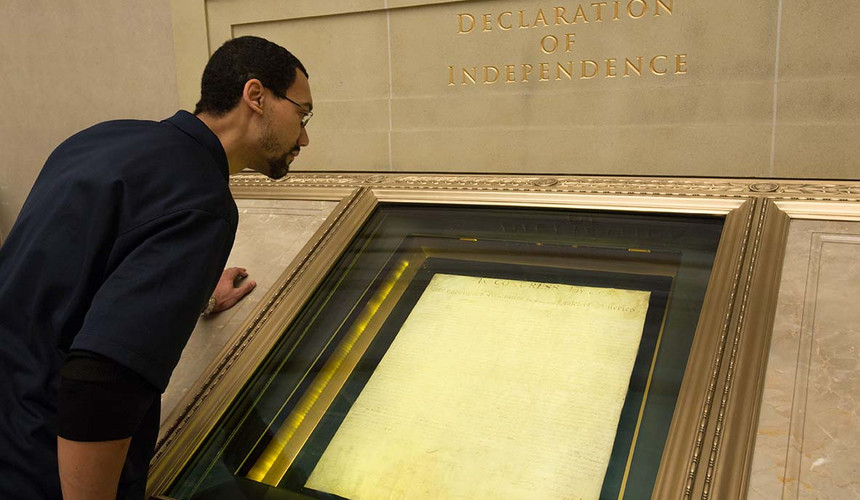My spouse and I are humanities nerds. On our (very promising) first date, I shared with him an idea I’d been mulling over: “We are the stories we tell ourselves about ourselves.” Now when people ask us for our “how we met” story, he says that’s the moment I captured his heart.
The heart of my work is storytelling. Exhibits are the stories museums tell our society about ourselves. Visitors use exhibits as backdrop and trove for their own stories of identity—all kinds of identities: personal, familial, communal, national. At the national museums in Washington, D.C., my self-understanding entwines with my beliefs about my country. I’m proud to feel represented by the Founding Documents displayed in their grand rotunda. I’m tickled to share generations of delight over Dorothy’s ruby slippers and Kermit the Frog. And I’m saddened and angry over the crazy brave crews of war planes, the ones that didn’t make it back to go on display at the Air and Space Museum.
Sources: National Archives, National Museum of American History, National Air and Space Museum
For better and for worse, these museums tell us about who we think we are—or, more often, who we wish we were. Because it’s easier for museums to tell stories that make us feel good about ourselves than ones that ask us to censure ourselves or our past.
For decades, the National Park Service masked our identity as a nation that profited from enslaving people. At Civil War parks until the 1990s—the '90s!—it was unofficial policy not to mention slavery as a factor in the Confederacy’s rebellion. Interpreters at battlefield parks talked about terrain and military tactics. The Park Service was trying to keep the peace with believers in the Lost Cause.

Gettysburg National Military Park; source: National Park Service
Eventually, NPS leaders dared to publicly (if obliquely) address the glaring omission in their storytelling. Managers from battlefield parks met and decided, in 1998, that their “interpretation must … illuminate the social, economic, and cultural issues that caused or were affected by the war.” [1] Congress’ appropriations bill in 2000 gave them cover, thanks to Congressman Jesse Jackson. It directed the NPS to “recognize…the unique role slavery played in causing the Civil War.” [2],
Exhibits that critique our past in new ways have gotten a lot of pushback. Many museum folks remember or have studied cautionary tales about the Enola Gay and West as America exhibits. (links)
There remains real debate among museum staff about whether their role is to influence visitors toward particular understandings. There’s legitimate concern about how to keep paying the bills if perceived activism scares off funders. Many institutions—at least half? maybe most?—continue to serve as refuges from uncomfortable stories rather than platforms for them. But in the dance between leading society and following it, it seems to me that museums have always taken incrementally progressive steps toward critical storytelling.
Two years ago, a mob broke into the U.S. Capitol building, demanding that Congress declare a different election result than the vote count showed. They had become the story they accepted as true: people robbed of the outcome they had chosen, now choosing to achieve it by force. Many people responded, "This is not who we are.” This mob doesn’t stand for our nation, doesn’t represent the democratic society we intend to be. The story of our country shouldn’t include these actions. And yet, clearly, it does.

Source: Tyler Merbler from USA, CC BY 2.0, via Wikimedia Commons
Staff from the National Museum of American History picked up signs and banners left behind by the rioters, collecting them for posterity. When put on display, how will the Museum interpret these objects? Exhibits aren’t great at communicating nuance, but, with some effort, I believe those objects could be used to recount: This is who we are but not who we aim to be.
That, after all, has been the story of the United States from the beginning. It’s not just heroic bombing crews, not just Kermit and Dorothy. It’s a set of ideals, recorded in our Founding Documents, that we have attempted to realize year after year and frequently fail to achieve. Just as museums have avoided telling the stories of those failures. We have to keep trying. I have to keep trying.
[1] Tucker, J. (2002). Interpreting Slavery and Civil Rights at Fort Sumter National Monument. George Wright Forum, 19(4), 21.
[2] Byrne, K. (2002). "We Have a Claim on This Estate": Remembering Slavery at Arlington House. CRM, 25(4), 27.






Comments